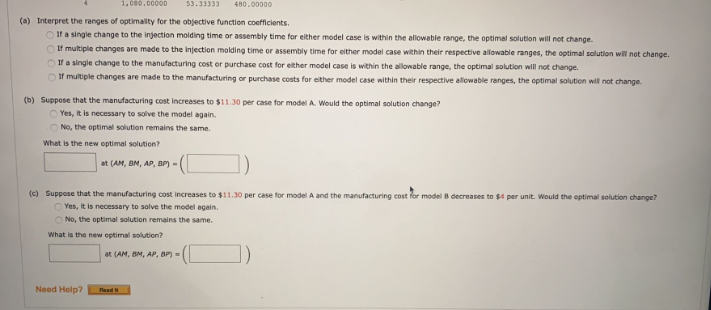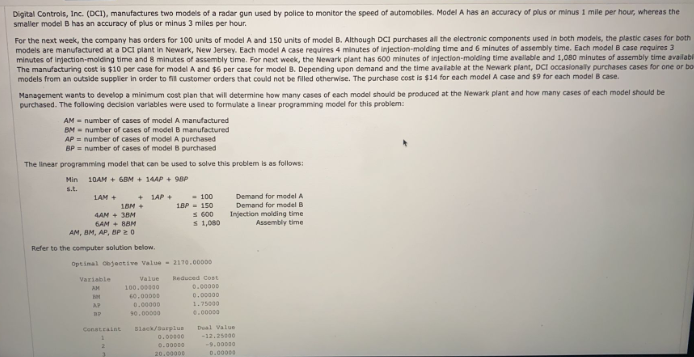Digital Controis, Inc. (DCI), manufactures two modeis of a radar gun used by police to monitor the speed of automobiles. Model A has an accuracy of plus or minus 1 mile per hour, whereas th smaller model B has an accuracy of plus or minus 3 miles per hour. For the next week, the company has orders for 100 units of model A and 150 units of model B. Athough DCI purchases all the electronic components used in both models, the plastic cases for models are manufactured at a DCI plant in Newark, New Jersey. Each model A case requares 4 minutes of injection-molding time and 6 minutes of assembly time. Each model B case requires 3 minutes of injection-moiding time and 8 minutes of assembly time. For next week, the Newark plant has 600 minutes of injection-molding time avalable and 1,080 minutes of assembly time a The manufacturing cost is $10 per case for model A and $6 per case feor model. Depending upon demand and the time avalable at the Newark plant, DCI occasionally purchases cases for one models from an outside suppler in order to fil customer orders that could not be filed otherwise. The purchase cost is $14 for each model A case and $9 for each model BCase Management wants to develop a minimum cost plan that wil determine how many cases of each model should be produced at the Newark plant and how many cases of each model should be purchased. The follwing decision variables were used to formulate a inear programming model for this problem: AM - number of cases of model A manufactured BM - number of cases of model B manufactured AP= number eof cases of model A purchased BP= number of cases of model 8 purchased The inear programming model that can be used to solve this problem is as follows Min 1GAM+ 6M 14AP 8 SL. + LAP+ - 100 18P- 150 Demand for model A Demend for model Injection malding time Assembly time LAM+ GAN AH s 1,080 AN, BM, AP, BP0 Refer to the computer selution below. Optinal jeetive Value210.00000 Variable Valse educed Cost 100.00000 0.000 40.00 e.000 1.750 e.00000 .0000 Conat.calet lack/arplu tal Valse
Digital Controis, Inc. (DCI), manufactures two modeis of a radar gun used by police to monitor the speed of automobiles. Model A has an accuracy of plus or minus 1 mile per hour, whereas th smaller model B has an accuracy of plus or minus 3 miles per hour. For the next week, the company has orders for 100 units of model A and 150 units of model B. Athough DCI purchases all the electronic components used in both models, the plastic cases for models are manufactured at a DCI plant in Newark, New Jersey. Each model A case requares 4 minutes of injection-molding time and 6 minutes of assembly time. Each model B case requires 3 minutes of injection-moiding time and 8 minutes of assembly time. For next week, the Newark plant has 600 minutes of injection-molding time avalable and 1,080 minutes of assembly time a The manufacturing cost is $10 per case for model A and $6 per case feor model. Depending upon demand and the time avalable at the Newark plant, DCI occasionally purchases cases for one models from an outside suppler in order to fil customer orders that could not be filed otherwise. The purchase cost is $14 for each model A case and $9 for each model BCase Management wants to develop a minimum cost plan that wil determine how many cases of each model should be produced at the Newark plant and how many cases of each model should be purchased. The follwing decision variables were used to formulate a inear programming model for this problem: AM - number of cases of model A manufactured BM - number of cases of model B manufactured AP= number eof cases of model A purchased BP= number of cases of model 8 purchased The inear programming model that can be used to solve this problem is as follows Min 1GAM+ 6M 14AP 8 SL. + LAP+ - 100 18P- 150 Demand for model A Demend for model Injection malding time Assembly time LAM+ GAN AH s 1,080 AN, BM, AP, BP0 Refer to the computer selution below. Optinal jeetive Value210.00000 Variable Valse educed Cost 100.00000 0.000 40.00 e.000 1.750 e.00000 .0000 Conat.calet lack/arplu tal Valse
Practical Management Science
6th Edition
ISBN:9781337406659
Author:WINSTON, Wayne L.
Publisher:WINSTON, Wayne L.
Chapter11: Simulation Models
Section: Chapter Questions
Problem 69P: The Tinkan Company produces one-pound cans for the Canadian salmon industry. Each year the salmon...
Related questions
Question

Transcribed Image Text:1,080.00000
53.33333
480.00000
(a) Interpret the ranges of optimality for the objective function coefficients.
OIt a single change to the injection molding time or assembly time for either model case is within the allowable range, the optimal solution will not change.
If multiple changes are made to the injection molding time or assembly time for either model case within their respective allowable ranges, the optimal solution will not change.
Of a single change to the manufacturing cost or purchase cost for either model case is within the allowable range, the optimal solution will not change.
OIf multiple changes are made to the manufacturing or purchase costs for either model case within their respective allowable ranges, the optimal solution will not change.
(b) Suppose that the manufacturing cost increases to $11.30 per case for model A. Would the optimal solution change?
O Yes, it is necessary to solve the model again.
O No, the optimal solution remains the same.
What is the new optimal solution?
at (AM, BM, AP, BP) -(
(c) Suppose that the manufacturing cost increases to $11.30 per case for model A and the manufacturing cost for model B decreases to $4 per unit. Would the optimal solution change?
O Yes, it is necessary to solve the model again.
O No, the optimal solution remains the same.
What is the new optimal solution?
at (AM, BM, AP, BP) =
Need Help?
Read h

Transcribed Image Text:Digital Controis, Inc. (DCI), manufactures two models of a radar gun used by police to monitor the speed of automobiles. Model A has an accuracy of plus or minus 1 mile per hour, whereas the
smaller model B has an accuracy of plus or minus 3 miles per hour.
For the next week, the company has orders for 100 units of model A and 150 units of model B. Although DCI purchases all the electronic components used in both models, the plastic cases for both
models are manufactured at a DCI plant in Newark, New Jersey. Each model A case requires 4 minutes of injection-molding time and 6 minutes of assembly time. Each model B case requires 3
minutes of injection-molding time and 8 minutes of assembly time. For next week, the Newark plant has 600 minutes of injection-molding time avallable and 1,080 minutes of assembly time availab
The manufacturing cost is $10 per case for model A and $6 per case for model B. Depending upon demand and the time avalable at the Newark plant, DCI occasionally purchases cases for one or bo
models from an outside supplier in order to fil customer orders that could not be filled otherwise. The purchase cost is $14 for each model A case and $9 for each model B case.
Management wants to develop a minimum cost plan that will determine how many cases of each model should be produced at the Newark plant and how many cases of each model should be
purchased. The following decislon varlables were used to formulate a lincar programming model for this problem:
AM - number of cases of model A manufactured
BM - number of cases of model B manufactured
AP = number of cases of model A purchased
BP = number of cases of model B purchased
The linear programming model that can be used to solve this problem is as follows:
Min
10AM + 6BM + 14AP + 98P
s.t.
- 100
18P- 150
s c00
S 1,080
Demand for model A
Demand for model B
Injection molding time
Assembly time
LAM +
1AP +
4AN + 3BM
GAM + BBM
AM, BM, AP, BP0
Refer to the computer solution below.
Optinal Objective Value- 2170.00000
Variable
Value
Reduced Cost
0.00000
0.00000
100.00000
60.00000
AP
0.00000
1.75000
90.00000
.00000
Constcaint
Black/surplun
Dual Value
-12.2500
9.000a0
D.000
0.0000
0.00000
20.00000
Expert Solution
This question has been solved!
Explore an expertly crafted, step-by-step solution for a thorough understanding of key concepts.
This is a popular solution!
Trending now
This is a popular solution!
Step by step
Solved in 2 steps with 2 images

Recommended textbooks for you

Practical Management Science
Operations Management
ISBN:
9781337406659
Author:
WINSTON, Wayne L.
Publisher:
Cengage,

Purchasing and Supply Chain Management
Operations Management
ISBN:
9781285869681
Author:
Robert M. Monczka, Robert B. Handfield, Larry C. Giunipero, James L. Patterson
Publisher:
Cengage Learning

Practical Management Science
Operations Management
ISBN:
9781337406659
Author:
WINSTON, Wayne L.
Publisher:
Cengage,

Purchasing and Supply Chain Management
Operations Management
ISBN:
9781285869681
Author:
Robert M. Monczka, Robert B. Handfield, Larry C. Giunipero, James L. Patterson
Publisher:
Cengage Learning